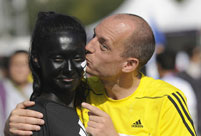LONDON, Oct. 24 -- More than 70 Chinese paintings, so famous and rarely seen that even many Chinese only know them by name, are being exhibited in London to help tell the history of Chinese painting.
The Victoria and Albert Museum, commonly abbreviated as the V&A, will open Masterpieces of Chinese Paintings 700-1900 this Saturday, an exhibition that will illustrate the evolution of Chinese painting using the finest examples created over a 1,200-year period.
The show gathers 79 paintings, as well as several items associated with Chinese painting tradition, and will last until Jan. 19, 2014.
"With this exhibition, we wanted to give those interested in China a history lesson," said Zhang Hongxing, a senior curator of Chinese collections at the museum.
"There are many foreign people who would like to know more about China, but to understand what the country is nowadays you need to learn its traditional culture."
Another aim of the exhibition is to correct the idea held by some that Chinese painting tradition seldom, if ever, changes. "We arranged the paintings chronologically and thematically in six successive periods to chart the evolving path," Zhang told Xinhua. "Chinese paintings have changed from religious to secular, from colorful to monochrome, from meticulous to freehand."
The exhibition begins by exploring paintings made for temples from 700 to 950 in the section titled Object of Devotion, where the majority of works were made for Buddhist liturgies or votive offerings by anonymous artists, and most surviving works are Buddhist banners and screens. They were painted on silk and characterized by their bright colors.
The next section is named The Quest for Reality with works from the period between 950 and 1250. Amid a growing enthusiasm for the natural world, at this time, China saw the rise of landscape painting.
Later, from 1250 to 1400, against the backdrop of suppression by the Mongol Yuan Dynasty, many people retreated to living in reclusion. The section Embracing Solitude tells visitors how painters at that time expressed their thoughts with calligraphy and poetry in their paintings.
The political stability and economic prosperity of the following Ming Dynasty saw an explosion in the arts. During 1400 and 1600, painters chose to reflect their happiness in real life, depicting scenes such as women playing football and golf.
The final period covered by the show, 1600 to 1900, was divided into two themes: Challenging the Past and Looking to the West. Painters at that time not only learned from the old masters, but also from Western techniques. Luo Pin from the Qing Dynasty even borrowed a skeleton figure from a print in the Netherlands.
Highlights at the exhibition include some pieces from Emperor Huizong in the Song Dynasty, such as the Auspicious Cranes and Court Ladies Preparing Newly Woven Silk. The latter was a household name in China, but, kept in Boston, rarely seen.
Apart from the paintings themselves, some items on display could help visitors understand Chinese art better, such as seals from Qing emperors and pigment unearthed in Dunhuang, a stop on the ancient Silk Road.
The exhibits came from 20 museums from all over the world, with only one third from China.
Zhang revealed that the preparation took four years. "Coordination with other museums was hard, because some of the paintings are too fragile and seldom on display now," he said.
For instance, one part of the diptych Two Chan Patriarchs Harmonizing Their Minds will be replaced half way through the exhibition, because it is unable to be shown for more than six weeks.
Martin Roth, director of the V&A, called the exhibition a "once-in-a-lifetime experience of seeing the greatest examples of Chinese painting together and understanding how they were created."
To celebrate the exhibition, two silk scarves inspired by the paintings are on sale. They were designed by X+Q Art, brainchild of two contemporary Chinese artists Qu Guangci and Xiang Jing.
 Low wages Indian migrant laborers
Low wages Indian migrant laborers Five fighters in flight training
Five fighters in flight training London mayor hails free trade, subway system on China tour
London mayor hails free trade, subway system on China tour Different eye catching shows at housing fairs in China
Different eye catching shows at housing fairs in China Special family portraits call attention to left-behind children
Special family portraits call attention to left-behind children Tibetan girl helps mobilize volunteers onlin
Tibetan girl helps mobilize volunteers onlin Lingerie show dazzles Wuhan Motor Show 2013
Lingerie show dazzles Wuhan Motor Show 2013  Running in fun customs at Beijing Int'l Marathon
Running in fun customs at Beijing Int'l Marathon  Weekly Sports Photos
Weekly Sports Photos Chinese riot police take Liberia peacekeeping mission
Chinese riot police take Liberia peacekeeping mission World has never been dark-- a blind kid’s life in Tibet
World has never been dark-- a blind kid’s life in Tibet Change to law may make it easier to sue polluters
Change to law may make it easier to sue polluters UNESCO world heritage site: Montale Tower
UNESCO world heritage site: Montale Tower U.S. Senate leader announces bipartisan deal
U.S. Senate leader announces bipartisan deal Chinese screen goddesses from Beijing Film Academy
Chinese screen goddesses from Beijing Film Academy Day|Week|Month